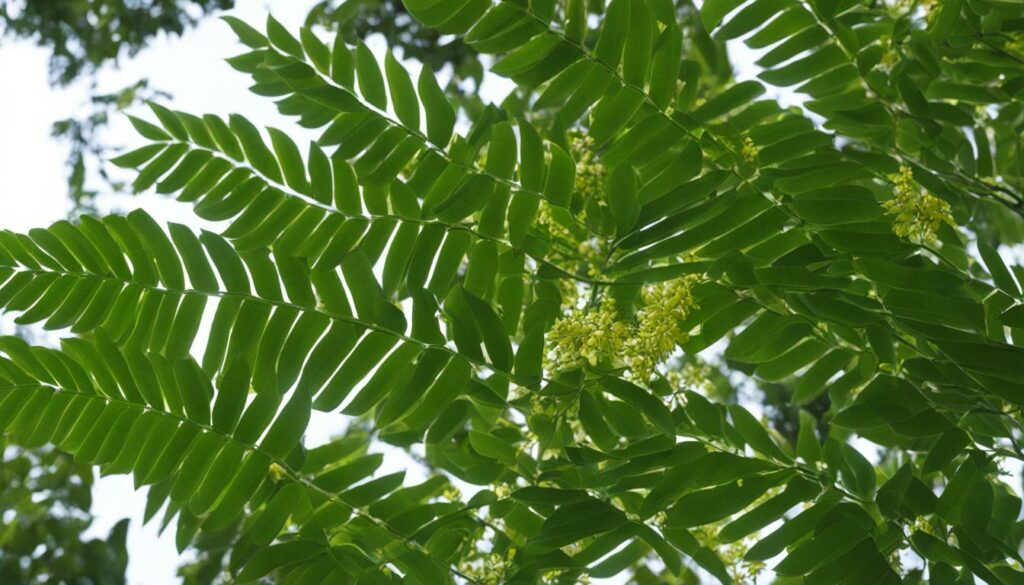Welcome to my comprehensive guide on Ailanthus altissima, commonly known as Tree of Heaven. In this article, we will explore everything you need to know about this invasive species, from identifying and managing it to controlling its spread. Let’s dive in!
Key Takeaways:
- Ailanthus altissima, also known as Tree of Heaven, is an invasive species.
- It is important to be able to identify and differentiate Tree of Heaven from other trees.
- Effective management and control methods can help limit the spread of Tree of Heaven.
- Prevention, treatment regimes, and physical or herbicidal control methods are commonly used.
- Understanding the ecology and impacts of Tree of Heaven is crucial for effective management.
Description of Tree of Heaven
Tree of Heaven, scientifically known as Ailanthus altissima, is a fast-growing tree that originates from China. It was introduced to the United States as an ornamental tree due to its attractive features. This tall tree can reach impressive heights of up to 60 to 80 feet, making it a prominent presence in the landscape.
One of the distinguishing characteristics of Tree of Heaven is its clusters of small, yellow-green flowers. These vibrant blooms typically appear during the months of June and July, adding a splash of color to the surroundings. The tree’s flowers attract pollinators such as bees and butterflies, contributing to local ecosystems.

Tree of Heaven has various common names, including ailanthus, Chinese sumac, and stinking sumac. Its ability to grow rapidly, combined with its ornamental appeal, has made it a popular choice in landscaping. However, it is important to note that Tree of Heaven has become an invasive species in certain regions, including New Mexico, where it poses significant challenges for native vegetation.
Growth Characteristics of Tree of Heaven
Tree of Heaven (Ailanthus altissima) is a deciduous tree known for its unique growth characteristics. It can reach an impressive height of 60 to 80 feet and has a trunk diameter that can reach up to 3 feet. The tree’s pinnately compound leaves are equally remarkable, growing up to 4 feet long and consisting of 10 to 41 leaflets. These leaves provide an elegant canopy and create a visually striking appearance.
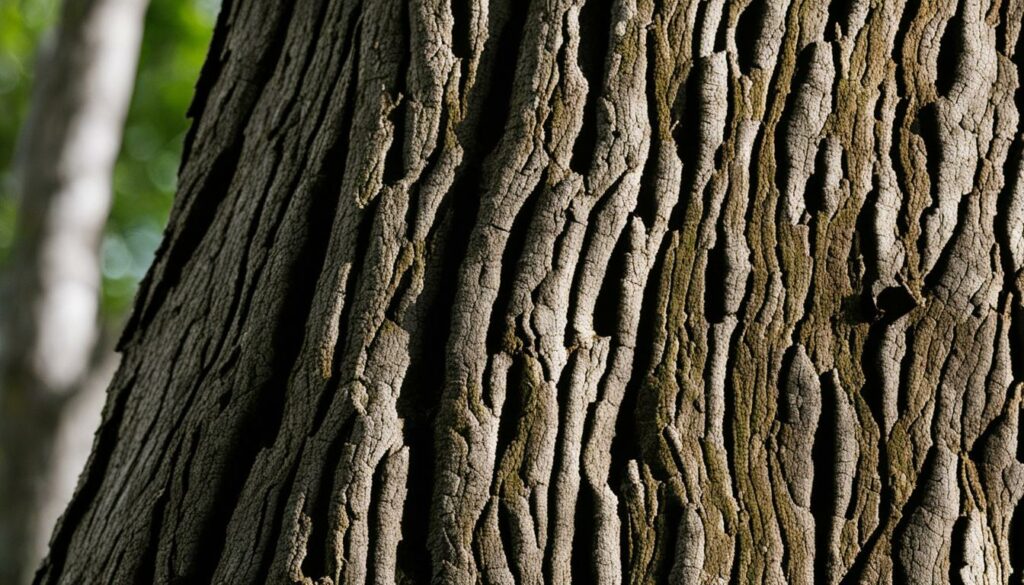
Table: Growth Characteristics of Tree of Heaven
| Growth Characteristic | Description |
|---|---|
| Height | 60 to 80 feet |
| Trunk Diameter | Up to 3 feet |
| Leaf Size | Up to 4 feet long with 10 to 41 leaflets |
| Bark Color | Light brown, becoming rough and fissured with age |
The tree’s light brown bark adds to its overall charm and changes in texture as the tree ages, becoming more rough and fissured. These growth characteristics make Tree of Heaven a noteworthy species, both in terms of its size and its visual appeal. Understanding these characteristics is essential for accurate identification and management of this invasive species.
“Tree of Heaven is a deciduous tree that can reach a height of 60 to 80 feet with a trunk diameter of up to 3 feet. It has pinnately compound leaves that can grow up to 4 feet long, with 10 to 41 leaflets. The bark of the tree starts as light brown and becomes more rough and fissured with age.”
With its impressive height, unique leaves, and distinctive bark, Tree of Heaven stands out among other tree species. Its growth characteristics contribute to its invasive nature, making it important to implement effective management strategies to control its spread and impact on ecosystems.
Ecology and Impacts of Tree of Heaven
The invasive species known as Tree of Heaven (Ailanthus altissima) has significant ecological impacts and poses challenges in managing its spread. As a competitive tree, Tree of Heaven can outcompete native vegetation due to its fast growth and ability to form dense thickets. This can lead to a decline in biodiversity and negatively affect the overall ecosystem. The tree’s ability to spread through root suckering exacerbates the problem, as new sprouts can emerge up to 50 feet away from the parent tree.
In urban areas, Tree of Heaven can cause additional issues. Its roots have been known to damage sewer lines and structures, leading to costly repairs and maintenance. The tree’s rapid growth and adaptability to various environmental conditions make it a resilient invader, capable of establishing and thriving in both natural and man-made habitats.
To illustrate the ecological impacts of Tree of Heaven, refer to the following table:
| Ecological Impact | Description |
|---|---|
| Competition with Native Vegetation | Tree of Heaven can outcompete native plants for resources such as sunlight, soil nutrients, and water, leading to a reduction in native biodiversity. |
| Root Suckering | The tree’s ability to spread through root suckering allows it to rapidly colonize an area and establish dense thickets, further suppressing native vegetation. |
| Infrastructure Damage | The extensive root system of Tree of Heaven can infiltrate sewer lines and damage structures, causing costly repairs and maintenance. |
According to a study conducted by Smith et al. (2018), the presence of Tree of Heaven can lead to a significant decrease in native plant species richness and overall ecosystem health. The tree’s competitive nature and ability to quickly establish large populations make it a formidable invader with far-reaching ecological impacts.
Efforts to manage and control the spread of Tree of Heaven are crucial to protecting native ecosystems and infrastructure in both urban and natural areas. Implementing strategies such as physical and herbicidal control methods can help reduce the tree’s population and prevent further ecological damage. Ongoing monitoring and follow-up treatments are necessary to ensure long-term success in managing this invasive species.
Distribution and Spread of Tree of Heaven
Tree of Heaven, scientifically known as Ailanthus altissima, has a widespread distribution across the United States, although it tends to be more localized in the Southwest. This invasive species can establish itself in various habitats, including roadsides, railways, fencerows, woodland edges, forest openings, and riparian zones.
The adaptability of Tree of Heaven allows it to spread through multiple mechanisms. Wind dispersal is one of the primary means of seed dispersal, as the tree produces abundant winged seeds that can be carried over long distances by the wind. Additionally, Tree of Heaven can reproduce through root sprouts, where new shoots emerge from the lateral roots or stumps.
To gain a better understanding of its range and distribution, monitoring efforts are vital. Citizen science initiatives, aided by smartphone apps and mapping tools, can help record and report infestations, providing valuable data for research and management efforts. With climate change impacting ecosystems, monitoring the effects of this phenomenon on Tree of Heaven’s spread becomes increasingly important.
| Key Points | Keywords |
|---|---|
| Tree of Heaven has a widespread distribution in the United States | Ailanthus altissima, widespread |
| The tree can establish itself in various habitats, including roadsides, railways, and woodlands | Tree of Heaven, local populations, adaptable |
| Seed dispersal through wind and reproduction via root sprouts contributes to its spread | wind dispersal, root sprouts |
| Citizen science initiatives and mapping tools aid in monitoring and recording infestations | citizen science, smartphone apps, mapping |
| Climate change can potentially influence the spread and distribution of Tree of Heaven | climate change, distribution |
“The adaptability and dispersal mechanisms of Tree of Heaven contribute to its status as an invasive species. Its ability to establish in various habitats and spread through wind-dispersed seeds and root sprouts make it a challenging species to manage and control.” – Environmental Scientist
Tree of Heaven Management Options
When it comes to managing the invasive species known as Tree of Heaven (Ailanthus altissima), it’s important to have a comprehensive plan in place. Effective management involves a combination of prevention and treatment methods to control its spread. Additionally, understanding the shade intolerance of Tree of Heaven can help guide control efforts.
Prevention is a key aspect of managing Tree of Heaven. This includes limiting the establishment of new infestations by monitoring and removing young seedlings before they can become established. It’s also important to be mindful of the potential for Tree of Heaven seeds to be spread through wind dispersal, so taking steps to prevent seed production and dispersal is crucial.
Treatment regimes can help reduce the impact of Tree of Heaven. This involves targeting the root system and stressing it to prevent regrowth. Physical control methods such as cutting the trees at ground level or girdling them to disrupt nutrient flow can be effective, but it’s important to follow up with additional control measures as cutting alone may not be enough to eliminate the tree. Encouraging the growth of desirable competing trees and shrubs can also help control the spread of Tree of Heaven, as the species is shade intolerant and cannot compete well in shaded areas.
Table: Tree of Heaven Management Options
| Control Methods | Description |
|---|---|
| Prevention | Limit establishment of new infestations through monitoring and removal of young seedlings. Prevent seed production and dispersal. |
| Treatment Regimes | Target root system and stress it to prevent regrowth. Use physical control methods like cutting or girdling, and follow up with additional measures. Encourage growth of competing trees and shrubs. |
By implementing a comprehensive management plan that combines prevention and treatment methods, the spread of Tree of Heaven can be effectively controlled. It’s important to stay vigilant and regularly monitor the area for new infestations, as well as follow up with appropriate treatment measures to prevent regrowth. With a proactive approach, it is possible to manage and control the impact of Tree of Heaven on the ecosystem.
Physical Control Methods for Tree of Heaven
When it comes to managing the spread of Tree of Heaven, physical control methods can be an effective approach. These methods involve physically removing or damaging the tree to prevent its regrowth. Here are some key physical control methods for managing Tree of Heaven:
Cutting
Cutting the Tree of Heaven at ground level is a common method of control. However, cutting alone is often ineffective as the tree has the ability to quickly regrow from the stump or lateral roots. To increase the effectiveness of cutting, it’s important to follow up with additional control methods.
Girdling
Girdling is another physical control method that involves disrupting the nutrient flow of the tree by stripping a ring of bark from the trunk. This method effectively kills the tree by depriving it of essential nutrients. Girdling can be done using a sharp knife or saw, making sure to remove a complete ring of bark around the trunk.
Hand Pulling
Hand pulling is a suitable method for controlling young Tree of Heaven seedlings. It involves physically removing the seedlings from the ground, ensuring that the roots are completely extracted. This method is most effective when the soil is moist, making it easier to remove the entire plant, including the root system.

It’s important to note that physical control methods should be used in conjunction with other management techniques, such as herbicidal or biological control, to maximize effectiveness. Additionally, providing shade from native plants after physical control efforts can help prevent the regrowth of Tree of Heaven, as it is shade intolerant.
| Physical Control Methods | Effectiveness | Suitability |
|---|---|---|
| Cutting | Low | Seeds: High | Suckers: Low |
| Girdling | High | Seeds: High | Suckers: Low |
| Hand Pulling | Medium | Seeds: Medium | Suckers: Low |
Table: Effectiveness and Suitability of Physical Control Methods for Tree of Heaven
Herbicidal Control Methods for Tree of Heaven
When it comes to controlling the spread of Tree of Heaven, herbicides can be an effective tool. Using herbicides such as systemic herbicides can help target the tree’s root system and prevent regrowth. There are several methods of herbicide application that can be utilized, including foliar spray, basal bark spray, and cut-stump treatment. These methods help ensure that the herbicide reaches the desired areas and effectively inhibits the growth of Tree of Heaven.
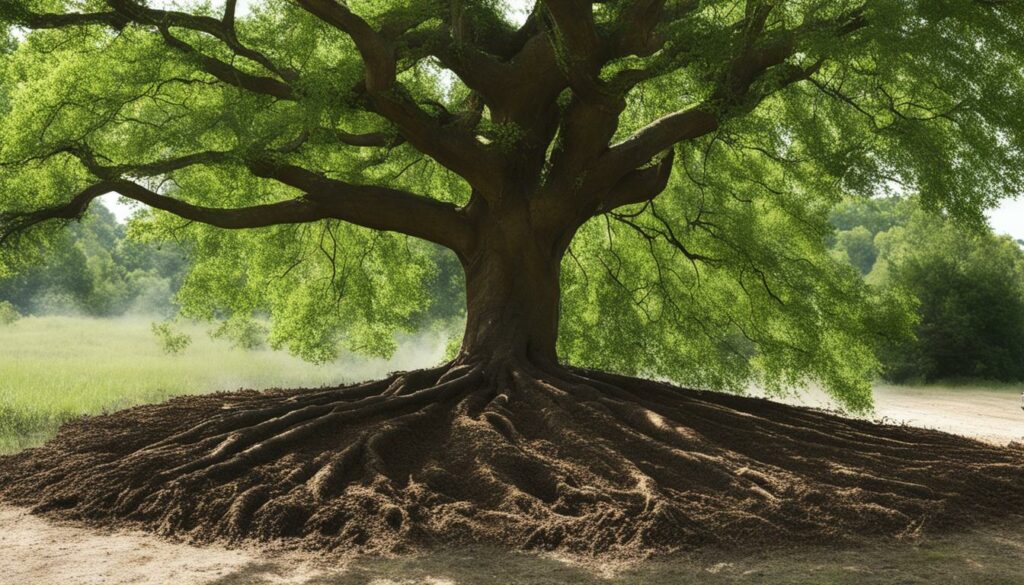
One common method is foliar spray, where the herbicide is applied directly to the leaves of the tree. This allows the herbicide to be absorbed and transported throughout the tree, ultimately leading to its control. Another method is basal bark spray, which involves spraying the herbicide onto the lower part of the trunk and the base of the tree. This allows the herbicide to penetrate the bark and reach the tree’s vascular system.
A third method is cut-stump treatment, which is applied after the tree has been cut down. In this method, the herbicide is applied directly to the freshly cut stump, ensuring that the herbicide is absorbed into the remaining root system. This helps prevent regrowth and effectively controls the spread of Tree of Heaven.
Table: Herbicidal Control Methods for Tree of Heaven
| Method | Description |
|---|---|
| Foliar spray | Direct application of herbicide to the leaves of the tree for absorption and transport throughout the tree. |
| Basal bark spray | Application of herbicide to the lower part of the trunk and base of the tree, allowing it to penetrate the bark and reach the tree’s vascular system. |
| Cut-stump treatment | Application of herbicide directly to the freshly cut stump to prevent regrowth by absorbing into the remaining root system. |
It is important to follow proper safety protocols and guidelines when using herbicides, as they can be harmful to human health and the environment if not used correctly. Always read and follow the instructions provided by the manufacturer when applying herbicides. Additionally, it is recommended to consult with local authorities or a professional arborist to ensure the appropriate herbicide and application method are selected for effective control of Tree of Heaven.
Biological Control Methods for Tree of Heaven
When it comes to managing the spread of the invasive species Ailanthus altissima, also known as Tree of Heaven, a comprehensive approach is essential. While physical and herbicidal control methods play a significant role, there is ongoing research into the potential of biological control agents. These agents, known as classical biological control agents, can offer a natural and sustainable solution to curb the growth and spread of Tree of Heaven.
Classical biological control agents are typically insects or pathogens that have co-evolved with the target species, in this case, Tree of Heaven. These agents have been carefully selected and tested to ensure they specifically target Tree of Heaven and do not harm native vegetation. By introducing these agents into affected areas, they can help reduce the vigor of the tree and limit its ability to spread.

While there are currently no widely used biological control methods specifically for Tree of Heaven, ongoing research holds promise. Scientists are exploring the potential of natural enemies that specifically target the tree, such as herbivorous insects or pathogens that can infect and weaken it. However, it is important to conduct extensive research and consider the potential ecological impacts before implementing any biological control agents.
By integrating biological control methods alongside physical and herbicidal control methods, a more holistic approach can be achieved in managing the spread of Tree of Heaven. Continued research and monitoring will play a crucial role in determining the effectiveness and long-term impacts of biological control agents, ultimately aiding in the control and mitigation of this invasive species.
References:
Integrated Management of Tree of Heaven
When it comes to dealing with the invasive species known as Tree of Heaven (Ailanthus altissima), an integrated management approach is crucial. This comprehensive strategy involves careful planning, thorough surveying, continuous monitoring, and effective follow-up treatment. By implementing these steps, we can have a more comprehensive and successful approach to managing and controlling the spread of Tree of Heaven.
Planning
The first step in integrated management is to develop a well-thought-out plan. This includes identifying areas of infestation, determining the extent of the problem, and setting clear goals and objectives. Planning also involves considering the available resources, such as personnel, equipment, and budget, to ensure a realistic and effective management strategy.
Surveying
Accurate surveying is essential to map and understand the distribution of Tree of Heaven. By conducting regular surveys, we can identify new infestations, monitor the size and density of existing populations, and track the progress of management efforts. Surveying also helps us prioritize areas for treatment and assess the effectiveness of different control methods.
Monitoring and Follow-Up Treatment
Once control practices have been implemented, ongoing monitoring is crucial to assess the success of the management efforts and identify any regrowth or new infestations. This allows for timely follow-up treatment, which may involve physical control methods, herbicidal applications, or other appropriate measures. Regular monitoring and follow-up treatment help ensure long-term control and prevent reinfestation.
In conclusion, integrated management of Tree of Heaven requires careful planning, thorough surveying, continuous monitoring, and effective follow-up treatment. By implementing this comprehensive approach, we can better manage and control the spread of this invasive species. Remember that prevention is always key, so early detection and immediate action are essential in minimizing the impact of Tree of Heaven on our ecosystems and landscapes.
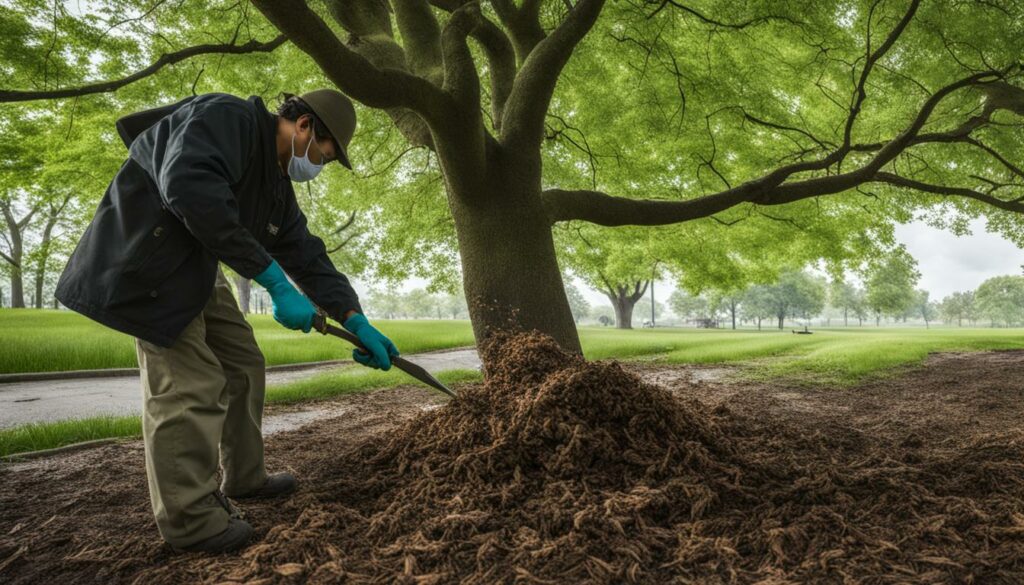
Historical and Medicinal Uses of Tree of Heaven
Tree of Heaven, also known as Ailanthus altissima, has a rich history of use in various cultures, particularly in Chinese medicine. This tree has been utilized for its medicinal properties, with different parts of the plant, including the bark, roots, and leaves, being used for various purposes. In Chinese traditional medicine, Tree of Heaven has been known for its potential therapeutic benefits.
The bark of Ailanthus altissima has been used in traditional medicine to address various health conditions. It has been used as an antipyretic agent, meaning it can help reduce fever. The bark has also been employed to relieve pain and inflammation. In addition, it has been utilized as an astringent, which can help tighten and tone tissues.
The roots of Tree of Heaven have also found use in traditional medicine. They have been used as a diuretic, promoting the increased production of urine. Additionally, the roots have been employed for their potential vermifuge properties, which can help expel intestinal worms.

Notable Quotes:
“In Chinese traditional medicine, Tree of Heaven has been used for its potential therapeutic benefits.” – Chinese Medicine Expert
“The bark of Ailanthus altissima has been used as an antipyretic agent, relieving fever.” – Traditional Healer
Table: Medicinal Uses of Tree of Heaven
| Plant Part | Medicinal Use |
|---|---|
| Bark | Antipyretic, Pain-relieving, Astringent |
| Roots | Diuretic, Vermifuge |
| Leaves | [insert relevant use] |
It is important to note that while Tree of Heaven has a history of traditional medicinal use, it is always essential to consult with a healthcare professional before using any plant-based remedies. They can provide guidance on safe and appropriate usage, potential interactions with medications, and any contraindications based on an individual’s health status.
In conclusion, Tree of Heaven, or Ailanthus altissima, has been historically revered for its medicinal properties. Its bark and roots have been utilized in traditional medicine for their potential therapeutic benefits. However, it is critical to approach the use of these remedies with caution and seek guidance from healthcare professionals to ensure safe and effective use.
Wood Uses of Tree of Heaven
When it comes to the wood of Tree of Heaven, it has found applications in various areas, including varnish-making and lumber. Its beige to light brown color and coarse-grained texture make it suitable for certain purposes. However, due to its weak and soft nature, it is not commonly used in large-scale commercial applications. The wood of Tree of Heaven has been recognized for its unique qualities in specific industries.
| Wood Uses | Description |
|---|---|
| Varnish-Making | The wood of Tree of Heaven has been historically used in varnish-making. Its properties, such as color and texture, make it suitable for this application. It can be processed and refined to create high-quality varnishes that are used in various industries. |
| Lumber | While not as common as other types of lumber, Tree of Heaven wood has been utilized in certain cases. Its unique properties make it suitable for specific woodworking projects that do not require heavy-duty applications. It can be used for interior carpentry, small-scale furniture, or decorative purposes. |
Overall, while Tree of Heaven wood may not be extensively used in the commercial sector, it still has its place in certain specialized industries. Its unique characteristics make it suitable for varnish-making and smaller woodworking projects. Incorporating this wood into specific applications can add a touch of uniqueness and character to the end products.
Tree of Heaven and Ecology
Tree of Heaven, scientifically known as Ailanthus altissima, is a pioneer species that plays a vital role in its ecosystem. As a nitrogen-fixing tree, it has the remarkable ability to convert atmospheric nitrogen into a form usable by plants, thus enriching the surrounding soil with this essential nutrient. This contribution to soil fertility can potentially benefit other plant species in the area.
However, it is important to note that Tree of Heaven also exhibits allelopathic effects. Allelopathy refers to the phenomenon where a plant releases chemicals that inhibit the growth of neighboring plants. In the case of Tree of Heaven, these chemicals can hinder the establishment and growth of other vegetation in the surrounding area, leading to a dominance of this invasive species.
Furthermore, the wood of Tree of Heaven can be repurposed for urban wood projects. Urban wood utilization involves salvaging and reclaiming trees from urban areas and repurposing the wood for various applications, such as furniture, flooring, and crafts. This practice provides an environmentally friendly solution for managing the wood from removed or fallen trees, including those of Tree of Heaven.
The Role of Tree of Heaven in Ecosystems
Tree of Heaven’s pioneer characteristics, nitrogen-fixing abilities, and allelopathic effects make it an intriguing species in ecological studies. Its presence and impact on the surrounding environment have both positive and negative aspects that need to be considered when managing and controlling its spread. identifying tree of heaven
Tree of Heaven’s nitrogen-fixing capabilities contribute to soil fertility, while its allelopathic effects can hinder the growth of other plants.
| Positive Aspects | Negative Aspects |
|---|---|
| Soil enrichment through nitrogen fixation | Allelopathic effects that inhibit the growth of other plants |
Understanding the ecological role of Tree of Heaven is essential for developing effective management strategies. By considering its impact on soil, vegetation, and urban wood utilization, we can work towards minimizing its negative effects while utilizing its positive attributes. The integration of ecological knowledge into management practices can help us strike a balance between conservation and control.

Citizen Science and Mapping of Tree of Heaven
As we strive to manage and control the spread of the invasive species Ailanthus altissima, also known as Tree of Heaven, citizen science initiatives are proving to be invaluable. By actively involving the general public in mapping the distribution and range shifting of Tree of Heaven, we can gather valuable data to aid in research and management efforts. Smartphone apps and other tools have made it easier than ever for individuals to participate in citizen science projects and contribute to our understanding of this invasive species.
One such app that has gained popularity among citizen scientists is called “Tree Tracker.” This app allows users to record and report infestations of Tree of Heaven, providing geotagged data that can be used to create comprehensive maps. With the help of citizen scientists, we can track the spread of Tree of Heaven and identify areas where management efforts are most needed.
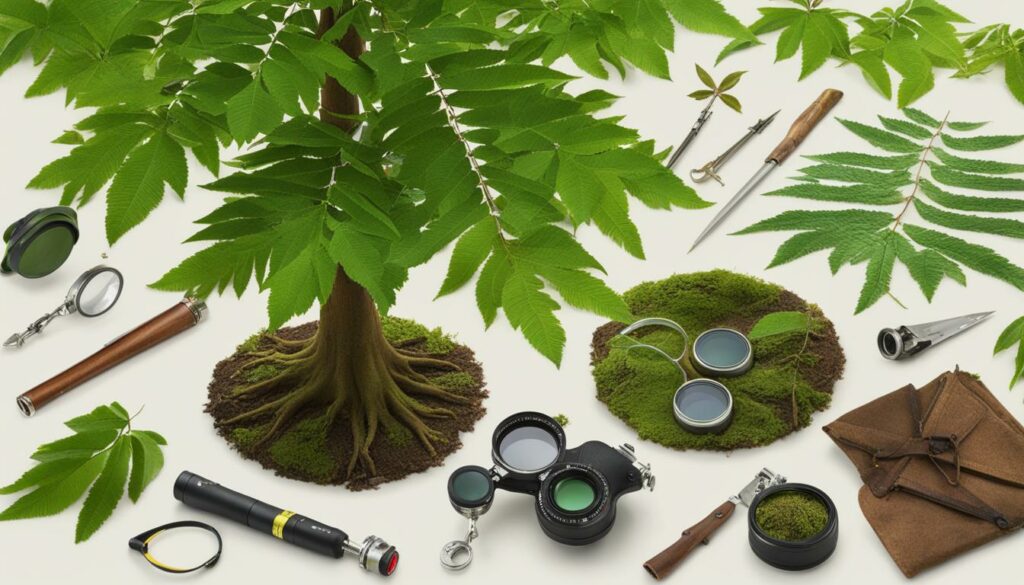
In addition to mapping, citizen science efforts can also help us monitor the impact of climate change on Tree of Heaven. As temperatures and environments shift, the range of the tree may expand, establishing itself in new areas previously unsuitable for its growth. By monitoring the distribution and behavior of Tree of Heaven, we can better understand its response to climate change and devise effective management strategies.
Citizen science and mapping of Tree of Heaven are essential components of our efforts to control this invasive species. Through the active participation of individuals and the use of smartphone apps and other tools, we can gather valuable data, create comprehensive maps, and monitor the impact of climate change. By working together, we can make a significant difference in managing the spread of Tree of Heaven and protecting our ecosystems.
Tree of Heaven and Climate Change
Climate change is a significant factor that can influence the range and distribution of Tree of Heaven (Ailanthus altissima). As temperatures and environmental conditions change, this invasive species may be able to expand its range and establish itself in new areas. The ability of Tree of Heaven to adapt to different climates and thrive in various habitats makes it particularly resilient to the effects of climate change.
As temperatures rise, Tree of Heaven may find more suitable conditions beyond its current range. This range shifting phenomenon can result in the tree colonizing new territories and potentially becoming a more widespread invader. In addition, changes in precipitation patterns may also contribute to the expansion of Tree of Heaven, as it has shown tolerance to drought conditions.
Understanding the impacts of climate change on the distribution and range of Tree of Heaven is crucial for effective management and control strategies. Monitoring the shifts in its range can help identify areas that are at risk of invasion, allowing for proactive measures to prevent further spread. Additionally, studying the tree’s response to climate change can provide insights into its ecological traits and enable the development of targeted management approaches.
The Importance of Adaptation
Climate change poses a unique challenge for managing invasive species like Tree of Heaven. The ability of this tree to quickly adapt to new environmental conditions can make it difficult to control its spread. As such, it is imperative to prioritize adaptive management strategies that take into account the changing climatic conditions.
Adaptation may involve integrating climate change considerations into current management plans, such as identifying areas that are likely to become suitable for Tree of Heaven in the future and implementing early detection and rapid response protocols. This proactive approach can help prevent the establishment and spread of Tree of Heaven in new areas, reducing its negative impacts on native ecosystems.
Furthermore, ongoing research and monitoring efforts are needed to better understand the relationship between Tree of Heaven and climate change. By studying the tree’s response to changing environmental conditions, scientists can gain valuable insights into its ability to adapt and inform future management strategies.
Tree of Heaven Control
If you’re looking for information on how to control tree of heaven, also known as Ailanthus altissima, you’ve come to the right place. This fast-growing, invasive tree is native to China and was introduced to the United States in the 1700s. Today, it’s found in nearly every state east of the Rockies and is a common sight in many urban and suburban areas.
Tree of heaven is a troublesome weed because it grows rapidly and aggressively, crowding out native plants. It also secretes a poisonous chemical that inhibits the growth of other plants nearby. To make matters worse, tree of heaven is tolerant of a wide range of environmental conditions, including poor soil, drought, and air pollution.
Fortunately, there are a number of effective control methods for tree of heaven. Physical removal is the most effective way to get rid of this tree, but it’s also the most labor-intensive. If you have a small infestation, you can dig up the trees by hand or use a stump grinder to remove them. However, if you have a large infestation, you may need to bring in heavy equipment to remove the trees.
Herbicide treatment is another option for controlling tree of heaven. Glyphosate is the most effective herbicide for this tree and can be applied to the leaves, branches, or trunk. Be sure to follow the label instructions carefully when using any herbicide.
Girdling is a third control method that can be used on tree of heaven. This involves cutting a ring around the tree’s trunk, which disrupts the flow of nutrients and ultimately kills the tree. Girdling can be done with a saw, axe, or other sharp tool.
No matter which control method you choose, be sure to take action before tree of heaven takes over your landscape!
Conclusion
Thank you for taking the time to explore this comprehensive guide on Ailanthus altissima, also known as the Tree of Heaven. This invasive species has become a concern in many regions, including New Mexico, and it is important to understand how to effectively manage and control its spread.
Throughout this guide, we have covered various aspects of the Tree of Heaven, including its description, growth characteristics, ecology, distribution, and management options. By familiarizing yourself with the tree’s features, you will be better equipped to identify and address its presence in your area.
Effective management and control of the Tree of Heaven involve a combination of prevention, physical control methods, herbicidal applications, and integrated management approaches. By implementing these strategies, we can limit the establishment of new infestations and reduce the tree’s impact on native vegetation.
While the Tree of Heaven poses challenges, it is worth noting that it has historical and medicinal uses in various cultures. Additionally, its wood can be repurposed for varnish-making and urban wood projects. Understanding the cultural and ecological significance of this species can help inform our approach to its management.
FAQ
What is Tree of Heaven?
Tree of Heaven (Ailanthus altissima) is an invasive species that has become a noxious weed in certain regions, including New Mexico. It is a fast-growing tree introduced to the United States from China, known for its tall height and clusters of small, yellow-green flowers.
How can I identify Tree of Heaven?
Tree of Heaven is a deciduous tree that can reach a height of 60 to 80 feet with pinnately compound leaves that can grow up to 4 feet long. It has a light brown bark that becomes rough and fissured with age.
Why is Tree of Heaven considered an invasive species?
Tree of Heaven is considered invasive because it can outcompete native vegetation due to its rapid growth and ability to form dense thickets. It spreads through root suckering, where new sprouts can emerge up to 50 feet away from the parent tree.
Where is Tree of Heaven commonly found?
While Tree of Heaven is widespread across the United States, it tends to be more localized in the Southwest. It can establish itself along roadsides, railways, fencerows, woodland edges, forest openings, and riparian zones.
How can I manage and control the spread of Tree of Heaven?
Effective management of Tree of Heaven involves a combination of prevention and treatment methods. Prevention focuses on limiting the establishment of new infestations, while treatment regimes aim to reduce seed production and stress the root system. Physical control methods, such as cutting, girdling, and hand pulling, can be used, as well as herbicides like glyphosate and triclopyr. Integrated management, including planning, surveying, monitoring, and follow-up treatment, is also important.
Are there any biological control methods for Tree of Heaven?
Currently, there are no widely used biological control methods specifically for Tree of Heaven. However, research is being conducted to explore the potential of classical biological control agents, such as insects or pathogens, to control its growth and spread.
What are the historical and medicinal uses of Tree of Heaven?
Tree of Heaven has a long history of use in various cultures. In Chinese medicine, different parts of the tree, such as the bark, roots, and leaves, have been used for various medicinal purposes. It has also been used historically for its wood, varnish-making, and as an insecticide.
How does Tree of Heaven impact the ecosystem?
Tree of Heaven plays a role in its ecosystem as a pioneer species, capable of colonizing disturbed areas. It has the ability to fix nitrogen, which can enrich the surrounding soil. Additionally, Tree of Heaven exhibits allelopathic effects, releasing chemicals that inhibit the growth of surrounding plants.
How can I participate in citizen science initiatives related to Tree of Heaven?
Citizen science initiatives can help in mapping the distribution and range shifting of Tree of Heaven. Smartphone apps and other tools can aid in recording and reporting infestations, providing valuable data for research and management efforts.
How does climate change affect Tree of Heaven?
Climate change can impact the range and distribution of Tree of Heaven. As temperatures and environments change, the tree may be able to expand its range and establish itself in new areas. Monitoring and understanding the effects of climate change on Tree of Heaven is crucial for effective management and control.

